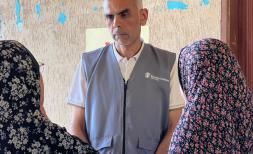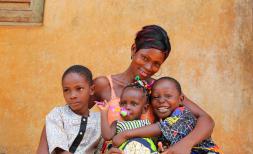Who is Left Behind in Research on Child Marriage?

Children take part of Bridge the Gap activities in Peru. Federico Obregon / Save the Children
The invisibility of child marriages and the continued high rate of child marriage in Latin America and the Caribbean are often attributed to gaps in the data on the prevalence of child marriage. Publications on child marriage in Latin America and the Caribbean, written in English, often fixate on this data gap, more so than in other regions of the world.
However, humanitarian groups such as the Gender-Based Violence (GBV) Area of Responsibility believe that we must move beyond prevalence data because it fails to capture the experiences of many survivors and unnecessarily risks harming survivors. Save the Children offers great options for addressing child marriage such as streamlining data collection, supporting girl-led movements, and addressing the social factors that lead to child marriage.
While shocking statistics have historically raised awareness of gender based violence GBV, their reliability, safety, and necessity are questionable. Firstly, under-reporting is widespread because of stigma, fear of retaliation, and survivor-blaming social beliefs and laws, and marginalisation due to other social identities like disability, class, citizenship, and work status. Secondly, data collection can be harmful as it asks respondents to disclose potentially traumatic experiences which may cause re-traumatisation (the exposure to triggers causing people to re-experience past trauma). Thirdly, disclosure can put participants at risk of retaliation. Finally, prevalence data primarily comes from Demographic and Health Surveys and Multiple Indicator Surveys conducted every three to 10 years, so it does not allow for necessary community-level analysis such as identifying context, drivers, and shorter-term trends.
Looking at child marriage, Latin America and the Caribbean is the only global region where rates have not decreased in the last 25 years but only 2% of child marriage research focuses on the region. Organisations have extensively blamed the so-called data and evidence gap. However, typical prevalence data fails to represent many of those affected by child marriage. This includes already married and/or pregnant girls, girls who have chosen to stay in or enter a marriage or union, and unofficial unions.
The deprioritisation of girls already in marriages and/or pregnant is reflected in the frequently centered goal of “[reducing] the rates of child marriage” and relatedly, there is much more funding available for prevention than response. However, in Latin America and the Caribbean, married and pregnant girls make up a large portion of those impacted by child marriage. It is important to support girls when prevention measures have failed.
The few sources that look at already married girls focus on girls who “escaped” as a surrogate for the idea of girls “fighting back against this harmful tradition.” It is imperative to remember that fighting back will not look the same for every survivor, and we must make space for those still in child marriages, including girls who chose to enter a marriage or union. Their choice may be influenced by oppressive forces limiting their agency, but we cannot forget girls’ ability to enact agency in situations with limited choices and use coping strategies for basic needs and survival. Responses must support the internal power of survivors.
Adding to the faultiness of previous statistical research, while underage marriage may be prohibited, this often pushes the practice to be carried out in a clandestine way. These unofficial unions are hard for governments to detect, especially because parents and community officials will often hide the unions. Girls in unofficial unions must be represented and cannot be reductively represented by a simple number.
This paper is not the first to critique prevalence data. The GBV Area of Responsibility advocates for the move away from prevalence data writing:
First, it is not ethical to collect GBV data when there are no services in place. Basic health care and psychological first aid must be locally available and accessible before [prevalence data collection.] Making funding for GBV services contingent upon the collection of primary prevalence data could delay the implementation of life-saving services…; this would go against humanitarian commitments related to the centrality of protection.
Additionally, collecting research and then taking services away from survivors is unethical. Service delivery and advocacy for the rights of girls related to child marriage is possible without prevalence data collection. We know this issue is occurring so we must take action.
Instead of focusing on prevalence data, the following actions should be considered:
The Gender-Based Violence Information Management System (GBVIMS) helps streamline data collection, which will help limit redundant data collection.
Research looking at 70 countries over 40 years found that ‘autonomous feminist movements’ were the most important factor for governments making laws that protect women and children against violence. Adolescent girls and their networks are a key part of these movements and we should support them and their distinctly powerful knowledge and leadership.
Conflict, climate disasters, the ongoing impacts of COVID-19 and the cost-of-living crisis are increasing risk of child marriage and threaten to further reverse progress for girls’ rights. Therefore these issues must be holistically addressed to combat child marriage.
We must rethink how we value and engage with all survivors’ experiences to prioritize their voices and care above all else. Moving beyond the practice of collecting prevalence data towards these strategies proposed by Save the Children is a step in the right direction.
Learn more about our work for Ending Child Marriage.







